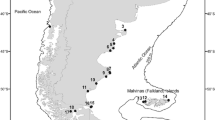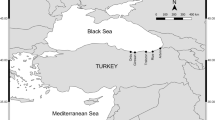Abstract
The object of the study was to determine whether the composition of the diet of sole Solea solea Linnaeus, 1758 throughout the year is influenced only by the presence and abundance of prey or whether in addition it is influenced by a selection procedure resulting from its energetic and nutritional needs. Feeding habits were established by examining the stomach contents of males and females throughout the year. We recorded the presence or absence of each prey item and identified dominant, occasional and accidental prey. Differences in the seasonal composition of the basic diet were analysed (chisquare). Throughout the year, the diet consisted mainly of crustaceans, except in autumn when polychaetes were the most abundant prey. Significant differences (chisquare) in feeding habits were established between seasons and between sexes in each season. Some of the dominant prey (Ampeliscidae and Callianassidae) live exclusively in estuaries and bays, and occur in highest abundance during winter, the season in which sole enter estuaries to spawn. These prey items were present in higher numbers in the stomach contents of the sole during this period, reflecting the dependence of its diet on prey availability.
Similar content being viewed by others
Literature cited
Braber, L., De Groot, S. J. (1973). The food of five flatfish species (Pleuronectiformes) in the northern North Sea: Neth. J. Sea Res. 6: 163–172
Dworschak, P. C. (1987). The biology of Upogebia pusilla. Mar. Ecol. 8: 337–358
Fincham, A. A. (1971) Ecology and population studies of some intertidal and sublittoral sand-dwelling amphipods. J. mar. Biol. Ass. U.K. 51: 471–488
Kaim Malka, R. A. (1969). Biologie el ecologie de quelques Ampelisca (Crustacea Amphipoda) de la region de Marseille. Téthys 1: 977–1022 (in Lagardère 1987)
Lagardère, J. P. (1987). Feeding ecology and daily food consumption of common sole, Solea vulgaris Quensel, juveniles on the French Atlantic coast. J. Fish Biol 30: 91–104
Molinero, A. (1986). Contribution al conocimiento de la biología de la F. Soleidae del delta del Ebro. Tesis doctoral. Universidad de Barcelona
Molinero, A., Flos, R. (1991). Influence of sex and age on the feeding habits of the common sole Solea solea. Mar. Biol. 111: 493–501
Pielou, C. (1975) Ecological diversity. Wiley, New York
Pitt, T. K. (1973) Food of American plaice (Hippoglossoides platessoides) from the Grand Bank, Newfoundland. J. Fish. Res. Bd Can. 30: 1261–1273
Quiniou, L. (1978). Les poissons démerseaux de la baie de Douarnenez; alimentation et écologie. Thèse 3ème cycle. Université de Bretagne Occidentale, Brest
Ramos, J. (1981). Règimen y comportamiento alimentario del lenguado (Solea solea L.). Infmes téc. inst. Invest. pesq. 83: 3–15
Ruiz, J., Jover, L. (1981) Sobre la alimentación otoñal de la garcilla bueyera — Bubulcus ibis — en el delta del Ebro, Tarragona. Publnes Dep. Zool. Univ. Barcelona 6: 65–72
Ruiz, J., Jover, L. (1983). Tipificación trófica de poblaciones mediante estimas de la dominancia y la diversidad. Trans. 15th int. Congr. Game. Biol. 695–707 (Sevilla)
Author information
Authors and Affiliations
Additional information
Communicated by J. M. Pérès, Marseille
Rights and permissions
About this article
Cite this article
Molinero, A., Flos, R. Influence of season on the feeding habits of the common sole Solea solea . Marine Biology 113, 499–507 (1992). https://doi.org/10.1007/BF00349177
Accepted:
Issue Date:
DOI: https://doi.org/10.1007/BF00349177




